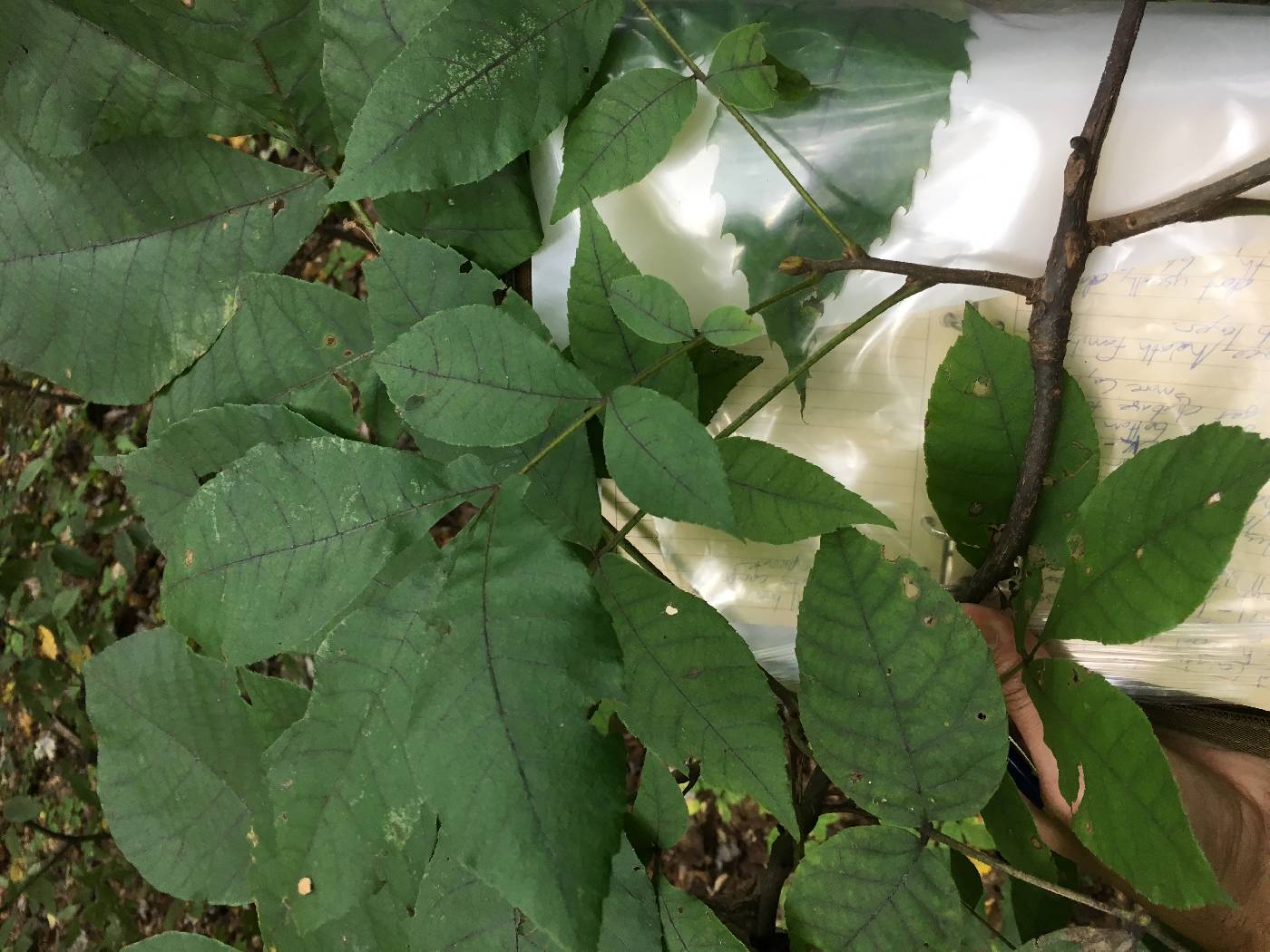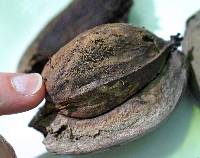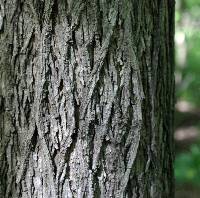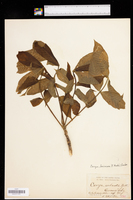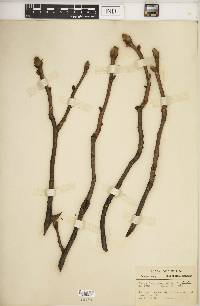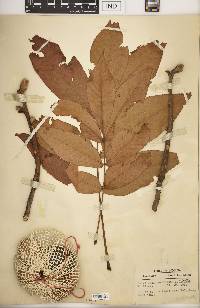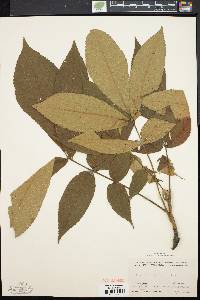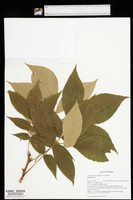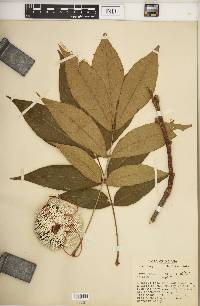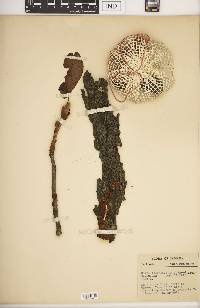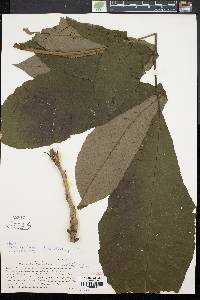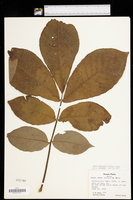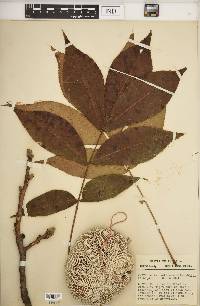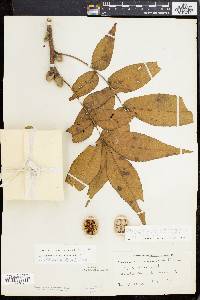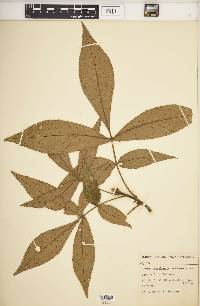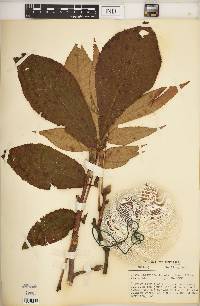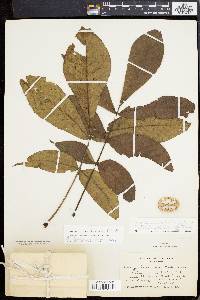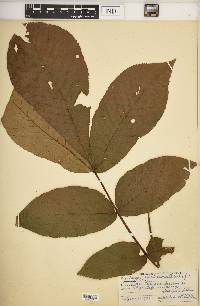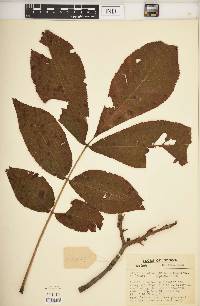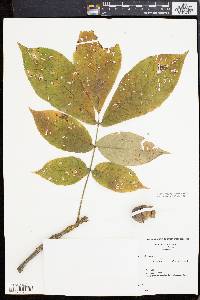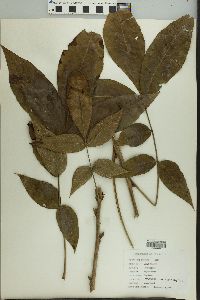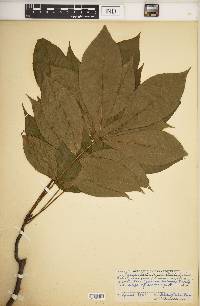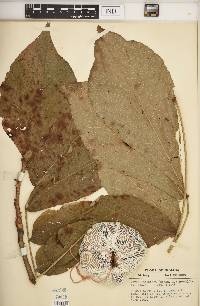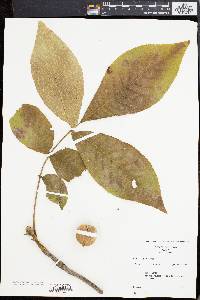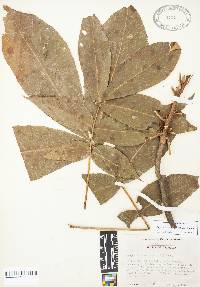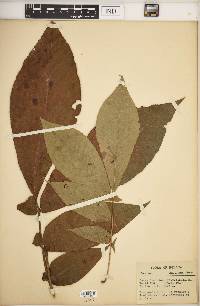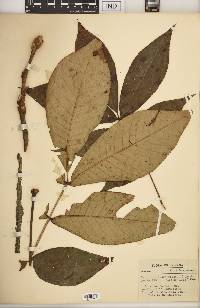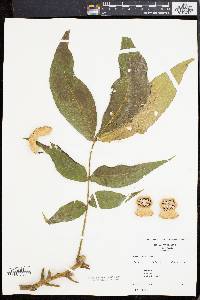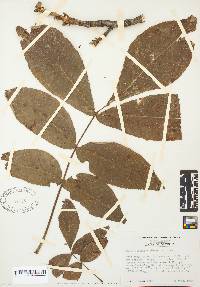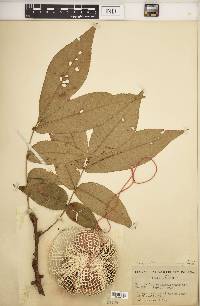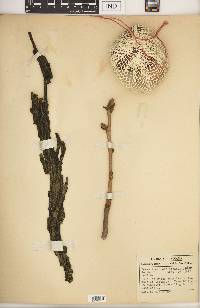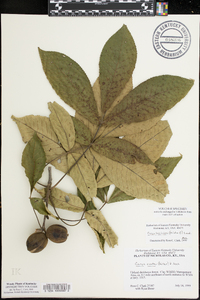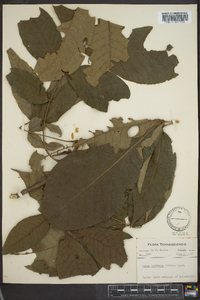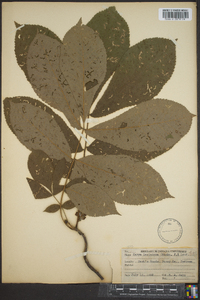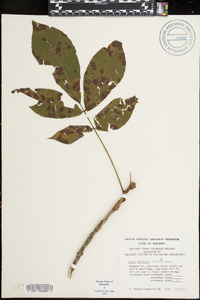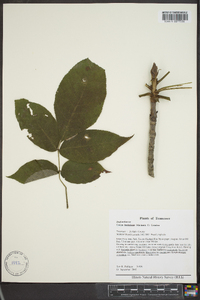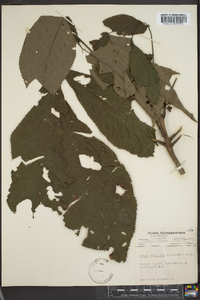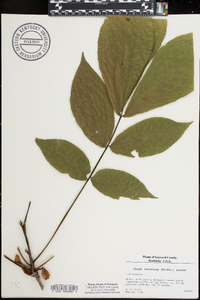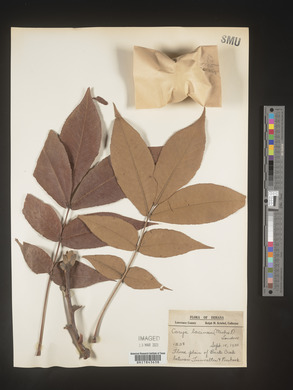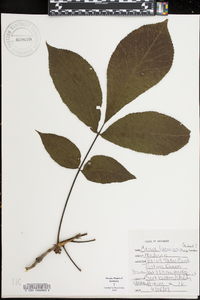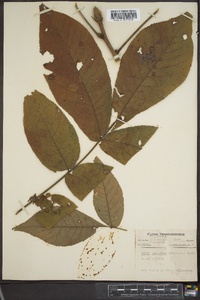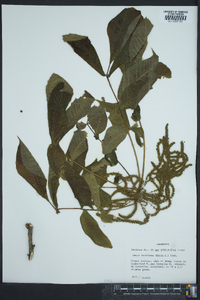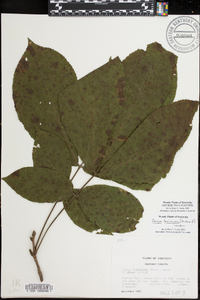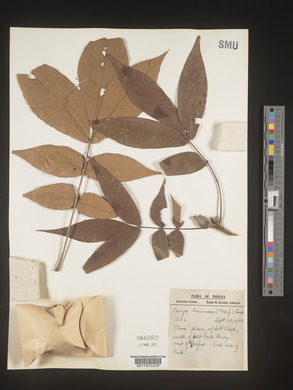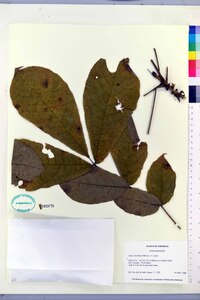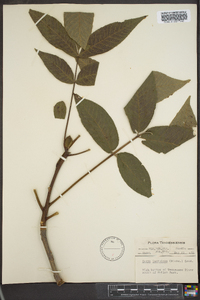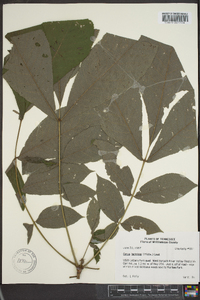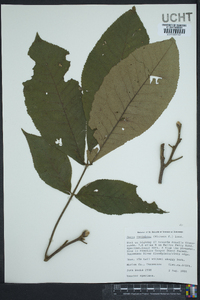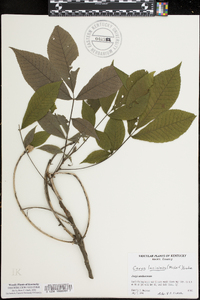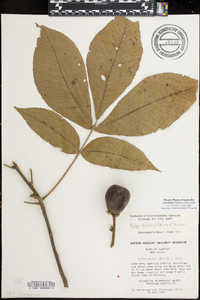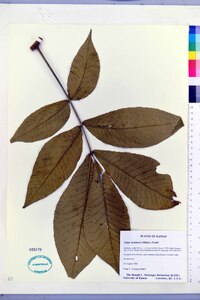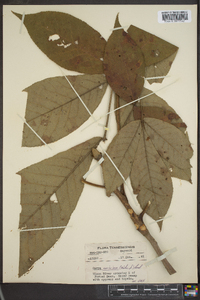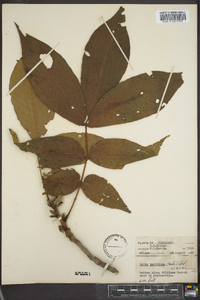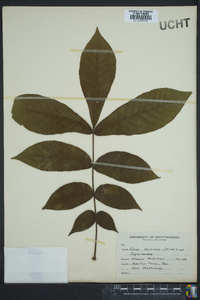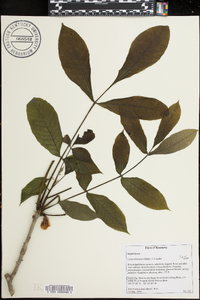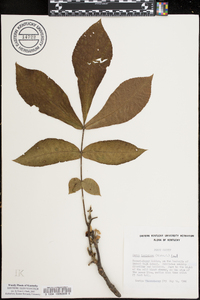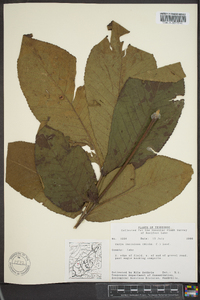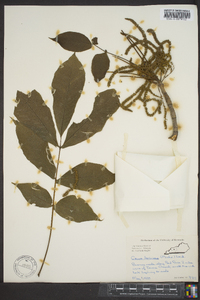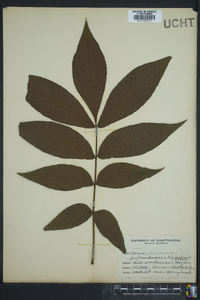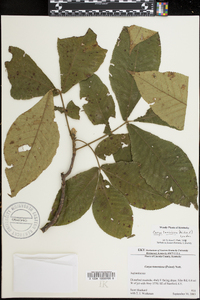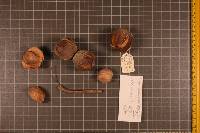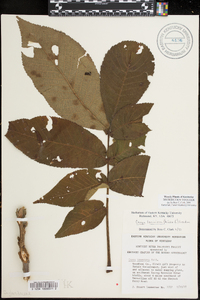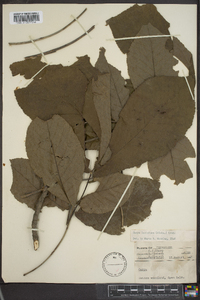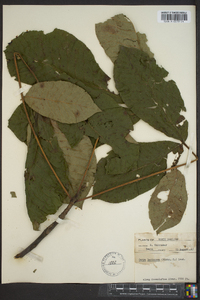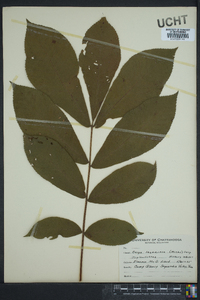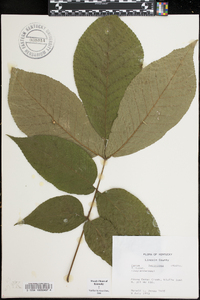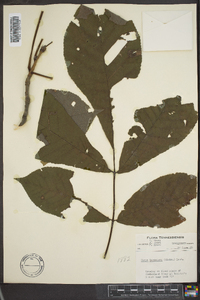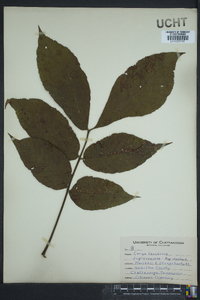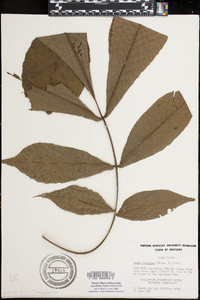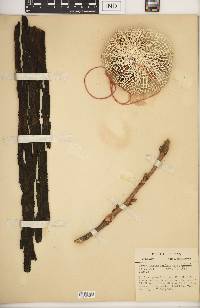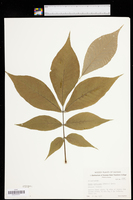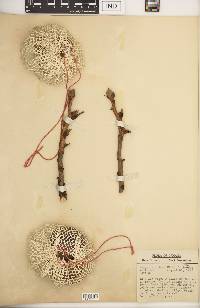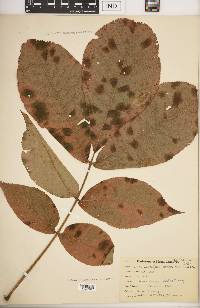Carya laciniosa
|
|
|
|
Family: Juglandaceae
Shell-Bark Hickory, more...Hard-Head Hickory, Big Scalybark Hickory
[Hicoria laciniosa (Michx. f.) Sarg., moreJuglans sulcata Willd.] |
Trees , to 41 m. Bark light gray, fissured or exfoliating, separating freely into large, thick, broad plates that persist. Twigs orange-tan, stout, hirsute, scaly. Terminal buds tan, broadly ovoid with apices of outer scales prolonged, 12-20 mm, tomentose; bud scales imbricate; axillary buds protected by bracteoles fused into hood. Leaves 6-9 dm; petiole 6-13 cm, minutely hirsute, becoming glabrous at base. Leaflets (5-)7-9(-11), lateral petiolules 0-1 mm, terminal petiolules 2-14 mm; blades ovate to obovate or elliptic, not falcate, 9-20 × 3-10 cm, margins coarsely serrate, apex narrowly acuminate; surfaces abaxially hirsute with unicellular, 2-6-rayed fasciculate and occasionally multiradiate hairs, scaly with abundant large peltate scales and small round peltate scales, adaxially hirsute along midrib, puberulent throughout. Staminate catkins pedunculate, to 20 cm, stalks and bracts minutely hirsute, capitate-glandular; anthers hirsute. Fruits tan to brown, spheric to ellipsoid, not compressed or slightly so, 4.5-6 × 4-5 cm; husks minutely hirsute, 7-13 mm thick, dehiscing to base, sutures smooth; nuts tan, ellipsoid, compressed, 4-angled, rugulose; shells thick. Seeds sweet. Flowering spring. Rich bottomlands, along creeks, and in open cedar glades; 20-300 m; Ont.; Ala., Ark., Del., Ga., Ill., Ind., Iowa, Kans., Ky., Md., Mich., Miss., Mo., N.Y., N.C., Ohio, Okla., Pa., Tenn., Tex., Va., W.Va. The most southern locality of Carya laciniosa is an outlier from Hardin County, Texas. Carya laciniosa hybridizes with C . illinoinensis ( C . × nussbaumeri Sargent) and C . ovata ( C . × dunbarii Sargent), and possibly C . cordiformis . Cherokee Indians used Carya laciniosa medicinally as an analgesic, a gastrointestinal aid, and a general disease remedy (D. E. Moerman 1986).
Tree 18 -25 m tall, trunk 0.36 - 0.8 m in diameter Leaves: alternate, odd-pinnately compound, 25 cm - 0.6 m long, usually with seven leaflets. Flowers: either male or female, found on the same tree (monoecious), male flowers in clusters of 3 hanging catkins 12 - 20 cm long, female flowers in short spikes of two to five. Fruit: a nut surrounded by a husk, 4.5 - 7 cm long, 4 - 5 cm wide. The husk is oblong to nearly spherical, thick, woody, and splitting to the base, and the nut is four- to six-ribbed. Bark: dark gray, smooth, developing narrow, 1 - 1.2 m long strips that curl on lower or both ends. Twigs: stout, orangish tan with orange corky raised spots (lenticels), hairy when young. Terminal buds: 2 - 3 cm long, egg-shaped, outer scales tan to dark brown and curling out slightly, inner scales yellow to purplish and hairy. Leaflets: 9 - 25 cm long, 5 - 12 cm wide, terminal leaflet usually largest, elliptic to egg-shaped or inversely egg-shaped, finely toothed, shiny dark green above, pale yellowish green with soft hairs beneath. Foliage is aromatic when crushed. Similar species: Carya cordiformis can be distinguished from other hickories by its sulfur-yellow buds that appear naked, nine narrow leaflets, fruit with a husk that splits to the middle, and bark that remains tight. Carya glabra has bark that remains tight except for a few shaggy strips, fairly smooth twigs, five to seven leaflets, pear-shaped to elliptical or spherical fruit with a husk that may split to the base, and small dome-shaped terminal buds.Carya ovata differs by its shaggy bark, foliage that smells like apples when crushed, five leaflets fringed with tufts of hair along the margins, nearly spherical husks that separate from a four-ridged nut, and large terminal buds with slightly curling outer scales. Carya tomentosa has fissured bark, densely hairy and reddish brown twigs, seven to nine leaflets with hairs beneath, and husks that split to the middle or base to reveal four-ridged nuts. Flowering: May to early June Habitat and ecology: Floodplains and wooded bottomlands. Occurence in the Chicago region: native Notes: Ax handles, skis and wagon hubs were once made with the strong wood of this species. The edible nuts have excellent flavor. Etymology: Carya comes from the Greek name for walnut. Laciniosa means shredded, referring to the bark. Author: The Morton Arboretum Bark as in no. 7 [Carya ovata (Mill.) K. Koch]; twigs and branchlets notably stout; buds large; lfls mostly 7-9, permanently pubescent beneath with fascicled hairs, the terminal oblanceolate to obovate, the lateral very inequilateral at base; fr ellipsoid to subglobose, 3.5-7 cm, its husk 6-12 mm thick, eventually splitting to the base; nut strongly compressed, 3-6 cm, prominently angled, somewhat wedge-shaped at base, very thick-walled; 2n=32. Flood plains; N.Y. and s. Ont. to Io. and e. Kans., s. to N.C., Ga., Miss., and e. Okla. Gleason, Henry A. & Cronquist, Arthur J. 1991. Manual of vascular plants of northeastern United States and adjacent Canada. lxxv + 910 pp. ©The New York Botanical Garden. All rights reserved. Used by permission. From Flora of Indiana (1940) by Charles C. Deam Rare, infrequent or frequent to common throughout the state, although there are no specimens or records from the northwestern counties. I was told that it occurred in the northern part of Porter County. It may be absent from a few of these counties. This species grows in wet woodland and is usually associated with the shagbark hickory. Locally it is common and throughout the Lower Wabash Valley it is common. It is associated with many species that inhabit wet woods and in one locality in the Spencer County Bottoms southwest of Rockport I found this species and beech the dominant trees. Exception: In the Lower Wabash Bottoms, there is a form of this hickory that has a tight bark, like that of the mockernut hickory, otherwise it is like the species. This form has the most palatable nut of the genus. The nut is compressed, short, of more than medium size, and has the best cracking quality of all the forms. I have known the nut of this form for many years but I have not had the opportunity of working out the taxonomy of it. For many years we bought nuts from this area for table use, and I was always able to recognize this nut without mistake. ...... Indiana Coefficient of Conservatism: C = 8 Wetland Indicator Status: FACW Deam (1932): The nuts are an article of commerce and by some are preferred to the shagbark hickory although they are hard to crack. This objection is easily overcome by wetting the nuts and drying them by using heat which cracks the shell, making them easy to crack. |

